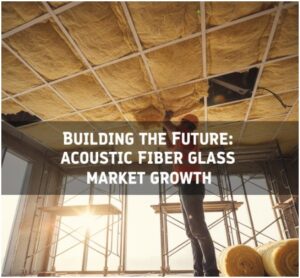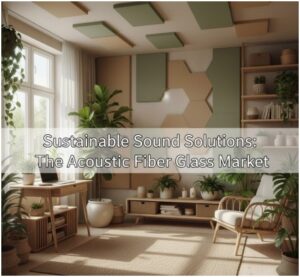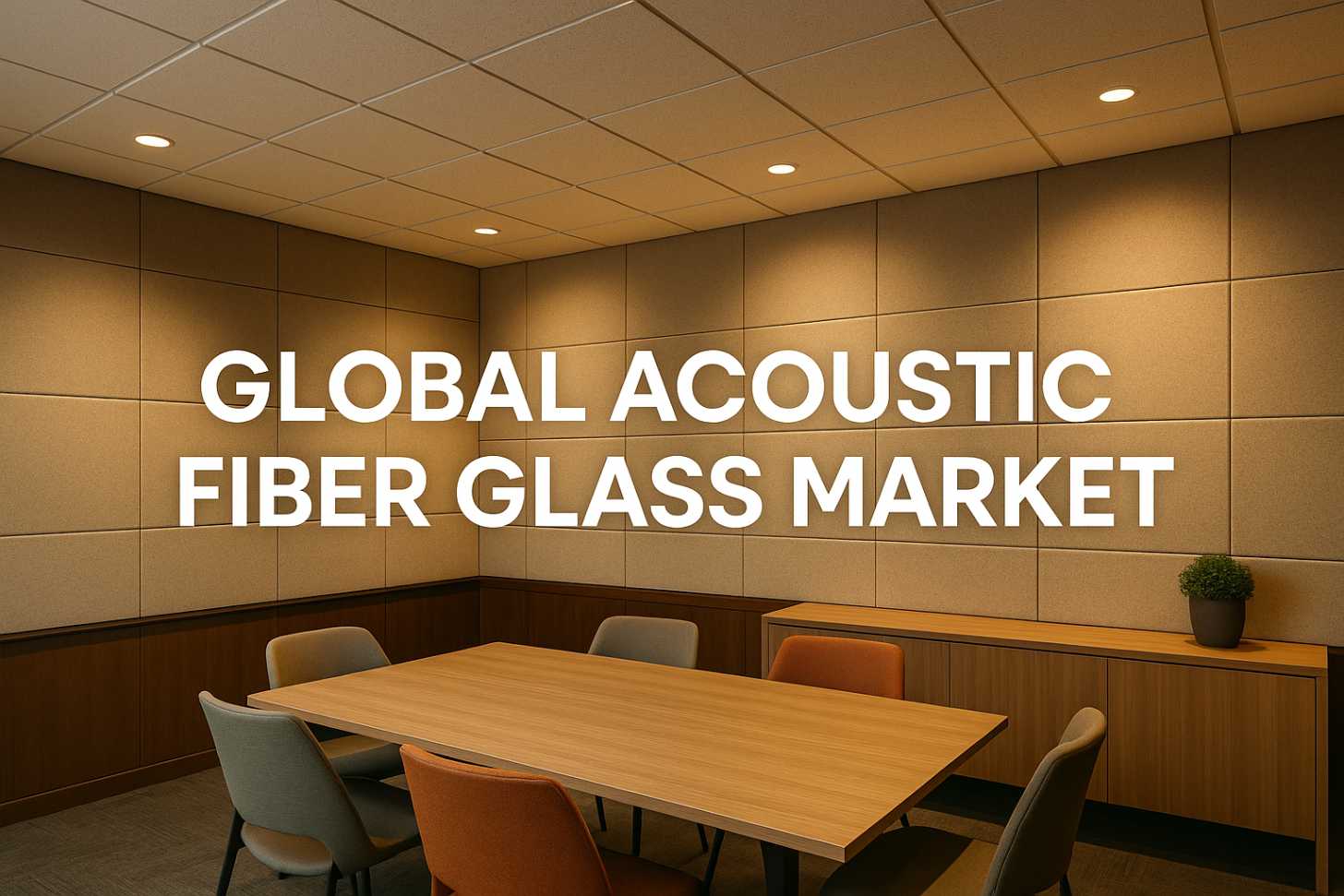I’ll be honest—I never thought I’d find fiberglass fascinating. But the day I stood in a recording studio wrapped in panels that completely silenced the outside world, I got it. That surreal, peaceful stillness wasn’t magic—it was science, powered by one of the unsung heroes of modern construction: the acoustic fiber glass market. Once I started digging into it, I realized this market is shaping how we live, work, and even feel in our spaces.
What Exactly Is the Acoustic Fiber Glass Market and Why Should You Care?

When people hear “fiberglass,” they usually picture itchy insulation rolls tucked into walls. But acoustic fiber glass is a different kind of genius—it’s engineered to absorb sound while keeping energy efficiency high. Think concert halls, office buildings, schools, and even your favorite cafés where you can actually hear yourself talk.
The acoustic fiber glass market sits at the intersection of comfort, sustainability, and innovation. It’s not just about muting noise—it’s about improving how humans experience space. From energy-efficient homes to corporate soundscapes that enhance productivity, fiberglass has evolved from a basic building material into a modern necessity.
How Big Is the Acoustic Fiber Glass Market Right Now?
Here’s where things get impressive. The global acoustic insulation market, which includes acoustic fiberglass, was valued at around $16.76 billion in 2025. By 2035, experts expect it to reach $27.94 billion, growing at a 5.4% CAGR.
And that’s just one slice of the pie. The fiberglass market overall—which includes both insulation and composites—is set to grow from $26 billion in 2024 to $34.9 billion by 2030. The star performer? Glass wool, a type of acoustic fiberglass known for its superior sound absorption and thermal efficiency.
Here’s a quick snapshot for context:
| Market Segment | 2024/2025 Value | Projected Value | CAGR |
| Acoustic Insulation | $16.76B (2025) | $27.94B (2035) | 5.4% |
| Acoustic Ceiling Tiles | $6.4B (2022) | $11.3B (2032) | 5.8% |
| Fiberglass (Overall) | $26B (2024) | $34.9B (2030) | 5.2% |
The acoustic fiber glass market isn’t just expanding—it’s echoing through every layer of modern construction.
What’s Driving the Growth of the Acoustic Fiber Glass Market?

I’ve noticed a growing shift in how people design spaces. It’s not just about how a room looks—it’s how it feels. The hum of traffic, chatter from next door, or the echo of an open office can ruin your focus. That’s where this market shines.
Several key trends fuel its growth:
- Urbanization and Construction Boom: Rapid development across Asia-Pacific, especially in China and India, keeps pushing the demand for noise-reducing materials.
- Health Awareness: People now recognize that noise pollution isn’t just annoying—it’s harmful. Constant noise links to stress, poor sleep, and even heart problems.
- Energy Efficiency Regulations: Governments are tightening rules for insulation and sustainability, which naturally boosts acoustic fiberglass adoption.
- Design Meets Function: Architects and interior designers love materials that balance aesthetics with performance. Fiberglass ceiling panels and wall tiles do exactly that.
When I renovated my workspace, the acoustic panels made such a difference—I could finally take Zoom calls without my dog barking echoing like surround sound. That’s when I realized this market isn’t just commercial—it’s deeply personal.
Who Are the Big Players Shaping the Market?
Every industry has its titans, and the acoustic fiber glass market is no exception. Some companies dominate through innovation, others through sheer scale, but all of them are pushing boundaries.
- Armstrong World Industries leads with cutting-edge acoustic ceiling and wall systems that blend art and engineering.
- CertainTeed Ceilings (Saint-Gobain) is part of the global construction powerhouse, championing sustainable glass wool solutions.
- Owens Corning practically invented fiberglass insulation and continues to innovate with its PINK Fiberglas brand.
- Knauf Insulation brings a global touch with advanced glass and rock wool options.
- Rockwool A/S goes beyond fiberglass, excelling in stone wool products with superior sound and fire resistance.
- Johns Manville Corporation delivers a diverse line of fiberglass insulation materials trusted worldwide.
Each of these names contributes to the acoustic revolution happening across commercial and residential construction.
How Can You Benefit From the Acoustic Fiber Glass Market?

If you’re a homeowner, builder, or business owner, this market affects you more than you think. The beauty of acoustic fiberglass lies in its versatility—it enhances sound quality while lowering energy costs.
You can use it in:
- Recording studios for clean, crisp audio.
- Open offices to minimize chatter and distractions.
- Home theaters for cinema-level sound.
- Apartments and hotels to improve privacy and comfort.
Investing in acoustic fiberglass solutions today means future-proofing your spaces for better well-being, sustainability, and property value. I’ve seen even small soundproofing upgrades make homes feel more peaceful—and that’s priceless.
How to Choose the Right Acoustic Fiberglass Solution
I’ve made my fair share of mistakes when choosing materials for renovations, but I’ve learned a few things worth sharing.
Step 1: Identify Your Noise Problem
Is it echo inside the room or noise leaking from outside? The right product depends on where the sound originates.
Step 2: Pick the Right Product Type
Ceiling tiles work best for office acoustics, while wall panels or insulation rolls suit homes and studios. Glass wool panels are the go-to for both sound absorption and thermal balance.
Step 3: Don’t Skip Professional Installation
Acoustic performance drops dramatically if materials aren’t installed correctly. Always work with a certified installer who understands how to position panels for maximum impact.
The best part? You don’t have to be a sound engineer to make your space quieter—you just need the right materials and mindset.
FAQs About the Acoustic Fiber Glass Market
1. What makes acoustic fiberglass different from regular fiberglass?
Acoustic fiberglass focuses on sound absorption. It’s denser, strategically structured, and used in ceilings, walls, and panels to minimize noise and echoes while maintaining insulation benefits.
2. Is acoustic fiberglass safe for home use?
Yes, absolutely. Modern fiberglass products meet strict health and safety standards. They’re sealed or faced to prevent fiber shedding, making them safe for both residential and commercial environments.
3. Which countries lead the acoustic fiber glass market?
The Asia-Pacific region, especially China and India, leads the way due to construction growth. North America and Europe also hold strong positions because of energy efficiency mandates.
4. Can acoustic fiberglass help reduce energy bills?
Definitely. Since glass wool provides both sound and thermal insulation, it helps regulate indoor temperatures. That means your HVAC system works less, saving you money in the long run.
Shhh… The Future Sounds Promising
Here’s my favorite part—the acoustic fiber glass market isn’t just growing; it’s transforming how we experience silence and comfort. As cities get noisier, materials that promote calmness and efficiency will define the future of construction.
If there’s one thing I’ve learned, it’s this: silence is a luxury worth investing in. Whether you’re building a skyscraper or upgrading your home office, acoustic fiberglass doesn’t just mute the world—it lets you live better within it.








